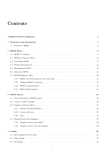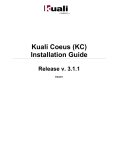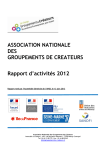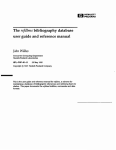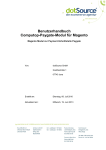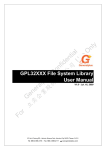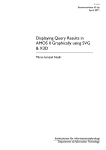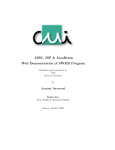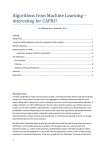Download Evaluation of RDBMS for use at Klarna
Transcript
IT 11 006
Examensarbete 30 hp
Februari 2011
Evaluation of RDBMS for use
at Klarna
Chen, Xiaoyu
Institutionen för informationsteknologi
Department of Information Technology
Abstract
Evaluation of RDBMS for use at Klarna
Chen, Xiaoyu
Teknisk- naturvetenskaplig fakultet
UTH-enheten
Besöksadress:
Ångströmlaboratoriet
Lägerhyddsvägen 1
Hus 4, Plan 0
Postadress:
Box 536
751 21 Uppsala
Telefon:
018 – 471 30 03
Telefax:
018 – 471 30 00
Hemsida:
http://www.teknat.uu.se/student
Corporate data plays a very important role in the business processing nowadays. It is
not only used as the mediate that records the personal information for the business
organization, but also keeps tracks of the valuable data about its customers and
transaction history. Any wise company has to make sure that its business data is safely
and correctly stored. There are many strategies used to guarantee the data security
and correctness. Referential integrity (RI) verifications as a one way is widely adopted
in the database system to make sure the data is correct and consistent.
RI is a property of data, which is usually implemented as constraint within a relational
database management system (RDBMS). It is used to establish relationships for two
referenced tables in RDBMS, such that a column of a table in a declared relationship
could only contain the values from the relative column of another table. The goal of
RI constraint is to enable RDBMS to have a reliable mechanism which can ensure the
database integrity and data consistency when doing a insert, update or delete into a
database and none of incorrect manipulation is accepted. Most mature and successful
commercial database products such as Oracle and Microsoft SQL Server support the
definition of RI constraints internally; On the other hand, the one which does not
support to enforce RI rules can be only called a database management system (DBMS)
such as Mnesia. Mnesia is an Erlang implemented distributed DBMS and especially
designed for telecommunication applications which require fast real-time and
non-stop services. However in the domain of telecommunication applications, RI
constraints were not critical features for the database system so Mnesia left them to
the programmers. In this case, RI constraints have to be implemented outside Mnesia.
Klarna AB is a financial company who supplies easy payment solution for online
customers. Kred system is an Erlang implemented product which is running by Klarna
AB for dealing with their daily business transactions. In this Kred system, Mnesia is
used as the DBMS and the RI constraints are implemented into the application layer
of the system. It is a stable system however the RI constraints implementation
strategy is not efficient. Hence in the following thesis, a research is investigated to find
out a new solution for this problem. In this new solution, the RI constraints
implementation will be separated from the database layer. A new layer rdbms with RI
enforcement will be established and inserted into the middle of the application layer
and the DBMS layer. The reason for calling the new layer rdbms is that a new
software called rdbms will be used to implement this new layer. Software rdbms is an
Erlang implemented module which could assist Mnesia to do data type and RI
constraints verifications. Hence the thesis will introduce the procedure of integrating
rdbms into Kred system, programming on rdbms in order to implement RI
constraints for Kred system. Later, an evaluation will be carried out to see if
software rdbms is mature and efficient enough to be integrated into the live system.
Handledare: Jonas Bergsten
Ämnesgranskare: Kjell Orsborn
Examinator: Anders Jansson
IT 11 006
Sponsor: Erik Stenman, Nicolae Paladi, Uwe Dauernheim, David Bingham
Tryckt av: Reprocentralen ITC
Content
Introduction ............................................................................................................ 7
1.1 Research background ................................................................................................. 7
1.2 Tasks of the thesis ...................................................................................................... 8
1.3 Outline of Thesis ........................................................................................................ 9
Theoretical Basis .................................................................................................. 10
2.1 Referential integrity ................................................................................................. 10
2.2 Data type .................................................................................................................. 11
2.3 Where to implement RI rules ................................................................................... 11
2.4 Strategies for implementing referential integrity ..................................................... 12
2.5 Selecting a solution for this thesis............................................................................ 14
Rdbms................................................................................................................... 15
3.1 What is rdbms?......................................................................................................... 15
3.2 How rdbms works .................................................................................................... 16
3.2.1 Workflow .............................................................................................................. 17
3.2.2 Rdbms objects ....................................................................................................... 23
3.3 Why rdbms............................................................................................................... 24
Implementation environment................................................................................ 26
4.1 Erlang ....................................................................................................................... 26
4.2 Kred system.............................................................................................................. 27
4.3 Mnesia...................................................................................................................... 28
Prototype............................................................................................................... 30
5.1 Design for a prototype.............................................................................................. 30
5.2 Rdbms API functions ............................................................................................... 32
5.2.1 set_property(Tab, Key, Value) ..........................................................................................32
5.2.2 type(Tab, Attr)...................................................................................................................34
5.2.3 tab_references(Tab) ...........................................................................................................34
5.2.4 drop_references(Tab).........................................................................................................34
System Integration................................................................................................ 35
6.1 Design for integration .............................................................................................. 35
6.2 Rdbms integration details......................................................................................... 36
Testing and Evaluation ......................................................................................... 39
7.1 Correctness testing ................................................................................................... 39
7.2 System performance evaluation ............................................................................... 43
7.3 Mnesia Benchmark evaluation ................................................................................. 45
7.3.1 Introduction .......................................................................................................................45
7.3.2 Benchmark evaluation with rdbms ....................................................................................48
Conclusion ............................................................................................................ 50
Acknowledgement ................................................................................................ 51
References ............................................................................................................ 51
Chapter 1
Introduction
1.1 Research background
Klarna AB [1] is a financial company created in 2005. It provides an easy
payment solution for a number of online customers who open the web stores on
the Internet. The numbers of their customers has boomed in recent years. Klarna
AB developed its own system Kred which deals with high volumes of small
transactions of trading everyday. Erlang/OTP [2] is the system programming
environment. Erlang is a functional programming language which was developed
by Ericsson [3] and it is designed especially for developing distributed
telecommunication projects. An Erlang embedded database Mnesia [4] is used as
the DBMS in Kred system. Based on Mnesia, the Kred system can supply nonstop and rapid search reply services for a big group of online customers who
make their online purchase day and night.
The reasons of Kred system selecting Erlang/OTP as the programming
environment are firstly because Erlang makes the programming easy and save.
Erlang is especially designed for providing accurate and non-stop services within
the distributed network environment. Hence it is suitable for the case of use of
Kred system; furthermore database Mnesia is characterized of providing multiusers response and having fast speed when doing key value look up. Kred system
needs these functionalities. Beside this, Mnesia is also powerful to cope with
complex objects and it supports hot swapping [5]. However, on the other hand,
Mnesia as mentioned above does not support definition of database constraints
especially Referential Integrity (RI) [6] constraints which requires the value of a
foreign key [7] in a table should match the value from another column of its
parent table [8] in the database. As a result, these constraints need to be
implemented somewhere else.
In the current Kred system, database constraints such as RI constraints are spread
out in different parts of the application objects and processes. It is no doubt that
these constraints could guarantee that the database always stays in a correct and
consistent state. However, it caused many problems. Firstly, there is a big
possibility that constraints defined in completely different objects, processes or
written by different programmers may conflict with each other. These conflicts
7
are hard to be detected. There is also a potential risk that the system rejects valid
database manipulate request. Secondly if these constraints are not implemented in
one common place, they will become invisible and hard to understand. Code is
difficult to adjust since we always have to take many parts and objects into
consideration when we want to make a change even it is a tiny one. Unnecessary
code redundancy may easily occur in the system.
1.2 Tasks of the thesis
Due to the problems found in the system, some research is needed to find out a
new solution. Because the name of the software ‘rdbms’ can easily confuse
people with another concept relational database management system (RDBMS).
In the rest of this thesis, word with lower case ‘rdbms’ will be only point to the
software; RDBMS with upper case of the letters will be the concept relational
database management system.
In this new solution, a new software rdbms is used to construct a new layer into
the Kred system. According to the description from rdbms user manual [9], rdbms
supports two sorts of database constraints definition. One is data type [10]
constraints, for instance, a name is string and an age is integer number. The other
is RI constraints. rdbms could assist Mnesia to check these data validations.
Hence the thesis will introduce a method of integrating rdbms into Kred system,
implement constraints verifications for Mnesia and at last, evaluate the new
system in order to see rdbms’s performances. Certain tasks are separated as
shown below:
z
Understand the mechanism of rdbms
z
Understand how to use rdbms API functions to define constraints; understand
how to call rdbms API functions to check data constraints
z
Design a method to integrate rdbms into the current Kred system
z
Integration implementation according to the method
z
Design and carry out evaluation on both old and new system and later
measure the results
z
Conclusion
8
1.3 Outline of Thesis
In Chapter 2, at the beginning, the thesis lists and explains a set of important
concepts involved in the study, including the definition of data type and
referential integrity. Later it introduces serveral popular strategies of
implementing RI constraints. Finally, a proper solution is selected from these
strategies after considering the Kred system’s architecture.
Chapter 3 explains the software studied in the thesis, rdbms in detail. At the
beginning, there is a brief introduction about rdbms. Afterwards it explains the
internal functionality of rdbms including how rdbms stores the data constraints
and what happens when rdbms checks the data validation.
Chapter 4 gives a brief introduction about the programming language Erlang/OTP;
the framework of the current Kred system and the DBMS adopted by the Kred
system, Mnesia.
Chapter 5 introduces a prototype implemented for the thesis before the system
integration. From which I practically learned how to use rdbms. In this chapter,
the basic design idea about this prototype is explained at the beginning. Then the
implementation details are described.
Chapter 6 introduces the integration process about rdbms including the designing
for the integration; the implementation of integration according to the design;
Code adjusting and changing into the Kred system; Problems solved during the
integration.
In chapter 7, a test is carried out to find out whether rdbms really works. Two
evaluations are executed to compare the new Kred system performance with the
old one.
Chapter 8 makes the conclusion for the thesis and then suggests future work.
9
Chapter 2
Theoretical Basis
This chapter explains several important concepts relating to the thesis work. Some
of them such as strategies for implementing RI rules are the theoretical
foundations for the thesis. At the end of this chapter, a proper solution is selected
according to the specific demands from the system involved in this thesis.
2.1 Referential integrity
RI is a property of data when satisfied, it requires that the values of the foreign
key in one table should target to the values in another column, usually a primary
key of the parent table. Figure 2.1 shows an example of referential integrity.
There are two tables, one is called employee and the other is called department.
Attribute department is the foreign key and it targets to attribute id which is a
primary key belongs to the table department. From the figure, we can see that all
the values of attribute department are existed in the table department. If in the
table employee, there is a record contains a department which is not appeared in
table department, for instance, a record {1004, Bob, Male, 3}, 3 is not appeared as
an element in attribute id, that means the referential integrity is violated.
Figure 2.1 Referential Integrity
In a RDBMS system, RI is enforced by respecting the following rules:
When inserting a new record into the table employee, this new record should not
have an attribute department N when N is not existed in attribute id. Otherwise
the insert is not accepted.
10
When a record is updated in the table department, if the value of attribute id is
changed, the value of attribute department of the relative records should be also
changed.
When a record is deleted from the table department, its relative records in the
table employee should be also deleted.
2.2 Data type
A data type is another property of data which defines which classification the data
belongs to. A data type could be a string, an integer or an atom. Most of
programming languages have the notion of data types. For instance, in statically
type languages such as Java and C, developers are able to define the data type for
variables and later use them within the code. In Erlang/OTP, there is no need to
declare the data type of variables before using them. Instead the programming
environment supports the ability to dynamically determine the data type for a
variable according to the value the developer assigns. Functions such as
is_integer(Attr) and is_list(Attr) are capable of judging if Attr belongs to a
specific classification or not. Boolean result ‘true’ or ‘false’ is returned back to
the tester.
2.3 Where to implement RI rules
Basically there are two choices as to where to implement RI rules. The first and
the traditional one is to implement it within database; and the other one is to
enforce RI constraints within application logic [11]. However it is not a black and
white issue to determine which approach is correct and which is wrong. Both of
these two approaches have their own advantages and also drawbacks. None of
them are perfect solutions. Before determining an approach for the system
implementation, you have to think about the architecture of your building system
first and then to analysis if the approach selection really works for you in practice.
RI rules can be implemented within database because modern RDBMS systems
such as MS SQL Server and Oracle support complex and powerful functionality
for RI definition. RI rules can be centralized controlled and enforced by the
database and they are also easy to be adjusted for the future. Hence database is a
ideal place to define RI rules. But this approach is only fit for the situation when
the application has single database and all the application objects respect to the
same RI rules. It is not fit for the modern distributed database environment, for
11
instance, a situation described in [12], tables with similar contents used by the
application may come from completely different database sources, but the
referential integrity rules in each database may also not the same. In this case,
referential integrity may be easily violated if RI rules are implemented within
database.
RI rules can be also implemented within application logic because database
development becomes more complex in modern times. RI starts to become a
business issue but not only for database so it may be implemented into a business
layer. This approach is especially fit for the distributed database environment in
which several RI rules are defined within application to satisfy different
requirements from the database sources. However because RI rules may be
implemented into certain number of objects within application, it will hide the RI
rules to be seen. RI rules may be also difficult to be changed because many parts
in the application have to be taken into consideration before you commit the
changes. Therefore conflicts may easily happen in RI implementation. In this
approach, the database can not be used without the application, otherwise it is
useless.
In conclusion, neither of these two approaches is perfect. The right choice is what
really helps for the system implementation. Sometimes, in a single system,
different application components may have different RI implementations.
2.4 Strategies for implementing referential integrity
From the practical point of view, there are several strategies to implement
referential integrity. The most popular and traditional strategy is database
constraints [13] which is also known as declarative referential integrity (DRI).
DRI is to define and enforce RI rules within database by using SQL database
programming languages in order to ensure the database integrity and table
structures. This strategy is to implement RI rules within database. For example, in
MS SQL server, a specific RI rule is established by defining a pair of primary key
constraint and its relative foreign key constraint.
Database triggers [14] is another strategy to implement RI rules within database.
It is a block of SQL code or other programming language code which is executed
when an event occurs into database. The event should be a particular data
manipulation transaction such as an insert, a delete or an update. Although
database trigger is usually used to implement complex business logic or keep
track of database manipulations, RI rules can be also implemented by database
12
triggers. For example, the syntax for creating a database trigger rule on Starburst
relational database system [15] at the IBM Almaden Research Center is:
create rule rule-name on table-name
when transition-predicate
[if condition,]
then action-list
The transition-predicate specifies the event to evoke this database trigger.
It could be inserted, deleted or updated. Once a rule is triggered, it will check if
the current state of database satisfies the condition rule or not. If the condition
evaluates to be true, the action-list is executed. We can use it to define a
particular RI rule on Starburst system. To assume we have two tables, an
employee and a department, we want to enforce a RI rule by which if we delete a
record from table department, all the employees who work for this department
have to be also removed from table employee. Then we define the database
trigger as:
create rule del-cascade on department
when deleted,
then ‘delete from employee
where employee.department in
(select d.id from d as (deleted())’
There is no condition for this rule, so the action is executed whenever there is a
delete into table department. A RI rule can be implemented like this. Compared
with database constraints, database trigger is able to define more complex RI
constraints.
Persistence framework [16] is a strategy to implement RI rules within application.
It is an approach to transform the data from RDBMS system to another format of
data and store them into an object which can be widely used by other applications.
During this process, RI rules are defined in the meta data as part of relationship
mapping. ObjectRelationalBridge (OJB) [17] is a typical Java persistence
framework tool which provides its application with transparent access to the
relational database. This strategy helps to assemble RI rules into a single meta
data repository outside the database instead of spreading them into many parts of
business objects. However, it requires that every application must base on the
same persistence framework.
RI rules can be also implemented as high level active rules [18] on top of the
database. In this strategy, instead of implementing database triggers inside
database, RI rules can be implemented by another deductive database language as
executable trigger monitor programs within applications. For instance, in [18] the
author uses a language called RDL1, implements active rules into a trigger
13
monitor layer on top of database layer by which RI rules are enforced. The
programs can be automatically evoked and executed according to the database
manipulation operations performed in the applications. This strategy can be taken
advantage of when the database does not support RI definition or RI rules can not
be sufficiently expressed inside database.
2.5 Selecting a solution for this thesis
There is no forever optimal strategy of implementing RI rules in a database
application. In order to select a proper solution, people have to understand the
system architecture first. Sometimes several strategies could be mixed together to
create a better solution.
According to the reality about the Kred system involved in this thesis, Mnesia is
used as the DBMS. Because it is not supported to define RI constraints inside
Mnesia, there is no choice but to implement them within application. Software
rdbms relies heavily on Mnesia functions and it is designed in the aim of assisting
Mnesia to enforce RI rules. Hence rdbms can be used as a deductive database
language for Mnesia by which RI constraints are implemented as a executable
program module on top of database. Strategy of implementing high level active
rules would be a best choice for Kred system. In Chapter 6, rdbms
implementation and integration will be illustrated in details.
14
Chapter 3
Rdbms
3.1 What is rdbms?
Rdbms is a Erlang/OTP implemented software which was written by Ulf Wiger
[19]. It ensures the data validation of Mnesia update including data type and RI
constraints verifications and it works as a Mneisa activity [20] callback module.
The Mnesia activity is a mechanism when a list of function objects is going to be
executed by Mnesia. Functions such as mnesia:lock/2, mnesia:write/3 and
mneisa:delete/3 will be forwarded to the Mnesia activity callback module in the
context of transaction. The Mnesia activity callback module is shown as
AccessMod in the figure 3.1 below. As a result, the Mneisa activity callback
module will execute these table manipulation functions as AcessMod:lock,
AcessMod:write and AcessMod:delete instead of Mnesia. Figure 3.1 vividly
explains how Mnesia activity works. ActivityId represents a unique transaction
context for the executing function objects.
15
The aim of executing functions within a transaction context is to satisfy a set of
properties which are called ACID in order to guarantee that the database is
updated correctly and reliably. According to the definition of AtomicityConsistency-Isolation-Durability (ACID) [21], A stands for atomicity, it requires
that either functions updating the database are executed completely or not at all.
Partial database updates are forbidden. C means consistency. It requires the
transaction to update the database from one consistent state to another. If any one
update fails, the entire transaction should be aborted completely. I stands for
isolation, if a table is updated by a transaction and not finished yet, no other
transaction is authorized to access this table until the previous transaction is done.
Also all reads should not be able to access a being write object until the write
transaction is committed. D stands for durability. It requires that the database is
able to recover the committed transaction if there is a system crash.
3.2 How rdbms works
In 3.2.1 it explains the internal workflow of different rdbms events. These events
include a definition for a specific data constraint and a look up for a data
16
constraint. In 3.2.2 a set of rdbms objects are listed with the explanation about
how these objects are used by rdbms.
3.2.1 Workflow
The workflow of different events of rdbms are going to be explained in this
section, including what happens when define a data type into rdbms, define a RI
constraint into rdbms, look up a data constraint from rdbms, insert a new object
into the table and delete a object from the table.
z
Define a data type
A new data type can be defined by calling rdbms API function set_property(Tab,
{attr, Attr, type}, Type). Three important parameters should be past to rdbms
which are Tab, a tuple {attr, Attr, type} and Type. Tab is a table name which
tells where the executing attribute comes from; the tuple {attr, Attr, type} tells
that the achieving goal is to define a data type for attribute Attr; Type tells the data
type to be defined. This function is to define the data type of attribute Attr. In
figure 3.2, it shows the workflow in which three steps are carried out for this
rdbms event.
17
There are three main steps when defining a new data type. In the first step, Type is
examined to make sure that it is recognizable for rdbms. The value of Type must
belong to a value list which is internally prescribed in rdbms. This list will be
described later in 3.2.2. In the second step, rdbms inserts a new tuple into an ets
table which is created by Mnesia at the very beginning when Mnesia is initialized.
The format of this tuple is {{attr, Attr, type}, Type} in which the new data
type is stored. An attribute of this ets table called cstruct which is used to keep the
database schema information for Mnesia and the tuple is inserted into a field
called user_properties which belongs to cstruct. In the third step, a new Erlang
file rdbms_verify_jit.erl is automatically generated by rdbms according to the
definition of the new data type. A timestamp is also generated and added to this
new file. Then this rdbms_verify_jit.erl is compiled and replaces the old ones.
z
Define a RI rule
The event of defining a new RI constraint is similar to the event of defining a new
data type. It can be achieved by calling rdbms API function set_property(Tab,
add_references, Value) in which three parameters are required. The first one is
Tab which tells the name of the executing table; the second one is always
add_references which tells the achieving goal is to define new RI constraints into
rdbms; the third one is Value which is a list explaining the RI constraints. Figure
3.3 describes the workflow for this event.
18
In the first step, rdbms reads the existing RI constraints from cstruct for table Tab.
Then in the second step, rdbms examines the validation of Value. If Value passes
the examination, in the third step a new list of RI constraints are merged by
combining the existing rules and the Value. If Value fails the examination, the
request is rejected. In this step, rdbms is not able to redefine a RI constraint which
has existed in rdbms. That means RI constraints can not be updated directly.
However we can drop it first and re-define it with the new constraint in order to
achieve updating. When it fails, the transaction will be aborted with the reason
“ref_integrity conflicts”. In the next step, the new generated list of RI constraints
is inserted into user_properties of cstruct for table Tab in the format of a tuple
{references, Newrefs}. In the last step, rdbms generates a new file,
rdbms_verify_jit.erl according to the changing. This file is automatically
compiled and replaces the old ones.
z
Look up an existing data constraint
When looking up an existing data constraint from rdbms, the system will fetch the
matched constraint based on the request from the field user_properties of cstruct.
The returning result is in the format of a tuple.
z
Insert a new object into the table
19
After the data constraints are properly defined into rdbms, we can start to see how
rdbms examines database updating according to these constraints. Figure 3.4
illustrates the workflow when an event of inserting a new object into the table
happens.
20
When a new object is to be inserted into the table, in the first step, rdbms
examines the validation of record Object. The examination includes checking if
the format of the Object is correct or not, if the value of every attributes in the
Object is correct or not. Two files rdbms_verify_jit.erl and rdbms_verify.erl are
involved in the data type violation checks. The former file provides the data type
definition for each attribute of the Object, the latter file decides if the examination
is passed or not. If the examination is failed, the insertion is aborted with the
reason “Data type violation”; otherwise a true is returned and it continues for the
next step. In the second step, the Object is inserted into the table. Then in the
third step, rdbms examines if Object respects RI constraint of table Tab or not. In
the beginning of this step, rdbms returns a list of existing RI constraints of table
Tab by reading from file rdbms_verify_jit.er. For each RI constraint in this list,
rdbms matches a list of referenced objects from the table. Then rdbms examines if
there is a violation or not by comparing the list of RI constraints and the
referenced objects. For instance, a table person has several attributes such as
name, age, sex and department. A table department has attributes such as name
and floor. There is a RI relation between object person and department in which
person’s department is the foreign key of department’s name. The department’s
name is a parent key. To assume a new object {person, {“Tony”, “25”, male,
“MIC”}} is to be inserted into table person while there is an object {department,
{“MIC”, 5}} which has been existed in table department. Rdbms will return a list
of referenced objects [{department, {“MIC”, 5}}] which means the RI constraint
is satisfied. However if rdbms return an empty list from table department, rdbms
must detect that this is a RI violation and therefore the transaction must be
aborted by rdbms. If it is aborted, an error “ref_integrity violation” is returned and
Object will be deleted from the table.
z
Delete an object from the table
When delete an object from the table, there are several steps rdbms will carry out
in order to satisfy the RI constraints. Figure 3.5 shows the rdbms workflow to
delete an object from the table.
21
Unlike inserting a new object, deleting an object from the table is sample. In the
first step, rdbms returns a list of deleting objects from the table according to the
key subscribed in the request. In the second step, a list of RI constraints for table
Tab is obtained by reading from the file rdbms_verify_jit.erl. For each RI
constraint in this list, rdbms matches a list of referenced objects from the tables.
In the next step, rdbms carries out a series of executions to the referenced objects
according to the RI constraints. Using the same example from the former
paragraph, we assume to delete an object {department, {“MIC”, 5}} from table
department. Rdbms will return a list of referenced objects [{person, {“Tony”,
“25”, male, “MIC”}}] from table person. Because the relationship between table
person and department, if the object {department, {“MIC”, 5}} is deleted from
the table, the objects related with this department must be also deleted at all.
Hence in this step, rdbms will firstly call Mnesia to delete the object of
department from the table and then the object of person is also deleted before the
transaction is finished.
22
3.2.2 Rdbms objects
z
Cstruct object
Cstruct is the Mnesia’s metadata object in which table schema information are
stored. These schema information includes fields such as the table name, access
mode and database storage. It is automatically generated in the beginning of
Mnesia initialization. Rdbms uses one field user_properties to store its additional
metadata such as RI constraints and data type as Mnesia. The value of data type is
stored in the format of {{attr, Attr, type}, Value} and RI constraints are in the
format of {references, [Refs]} in user_properties.
z
Rdbms_verify_jit.erl and rdbms_verify.erl
Both of these two files manage the data constraints in rdbms. rdbms_verify_jit.erl
is repeatedly generated to provide the latest data constraints for rdbms. This file is
generated by merging the old constraints with the updated ones whenever there is
an rdbms event happening which makes a change about the current data
constraints. A time stamp is also created based on the right now time and it is
added as part of the file name. The new file is to be compiled and replaces the old
ones. File rdbms_verify_jit.erl can store the data constraints for tables as well as
user_properties does. But they are used in completely different situations. The
former one is used as a dictionary for looking up a data constraint according to
the request; rdbms_verify_jit.erl is an Erlang module which is used to directly
carry out the verifications. It is much faster.
There are also difference between file rdbms_verify_jit.erl and rdbms_verify.erl.
We can say that rdbms_verify_jit.erl defines the scenario of verification, on the
other hand, rdbms_verify.erl judges if the request passes verification or not. To
explain it in another way, rdbms_verify_jit.erl subscribes what to check. For
instance, it subscribes to check the value of a personal number P is integer or not.
Then it calls rdbms_verify.erl in which it returns true if the value is an integer or
false if P fails the examination.
z
A list of valid data type
Rdbms internally subscribes a list of identifiable data types. The list is able to be
obtained by calling rdbs API function rdbms_props:simple_builtin_types(), then
a list [any, undefined, atom, integer, float, number, string, text, list, nil, tuple, pid,
port, reference, binary, oid, function] is returned. rdbms supports to add
customized data types.
z
Rdbms:perform_ref_actions/8
23
This function subscribes the actions how rdbms have to deal with the referenced
objects if there is a database update in order to satisfy the RI constraints. Actions
can be opted from a list [cascade, set_null, set_default, no_action, ignore]. These
actions illustrate how rdbms have to copy with the referenced objects for database
updating. For instance, cascade illustrates that if an object is to be deleted from
the parent table, a cascade deletion have to be carried out into the foreign table.
Action list will be discussed in details in the prototype.
z
Compile rdbms_verify_jit.erl
Rdbms_verify_jit.erl is complied by rdbms By calling API function
compile:forms(Forms, [Options]), Forms can be either an Erlang module’s
name or a piece of abstract format code. Options can be report_errors,
report_warnings or both of them. Then the result could be either {error,
Information} or {ok, rdbms, Binary[,Warnings]} according to the truth if the
code is correct or not. An object code Binary is generated if the compiling is done
and replaces the old one. No object file is generated. The replace will happen
without stopping the running program. Because rdbms_verify_jit.erl must be
generated and compiled frequently, it badly affects the performance of the system.
Fortunately data constraints are commonly defined once for all at the very
beginning of initializing Mnesia.
3.3 Why rdbms
Due to the reason that Mnesia does not support to define the data constraints
internally, we have to find some other way to implement them in the application
layer. Rdbms was especially designed as a separate call back module which offers
definition of data type and RI constraints and it helps Mnesia to execute data
constraints verifications. Hence rdbms is a good solution for this problem.
Furthermore, Klarna system Kred is a typical business application in which all
data is stored and controlled by a centralized database server node. Besides, all
the application objects and processes respect to the same data constraints. Hence
to implement RI constraints within a common place in the application layer is
suitable for Kred system. In this case, the database application will work
efficiently. Rdbms for this case is a wise choice for Kred system. It could
assemble both RI constraints and data type definition within an independent layer
in Kred system by replacing the current implementation that all of them are
spreading out into application layers.
Thirdly, the costing time on integrating rdbms into Kred system could be fast.
The reason is that rdbms was especially designed as a Mnesia activity call back
24
module. The activate rdbms for Mnesia could be easily achieved by writing
several lines of code if we use a proper version of Mnesia. Rdbms has no bad
effects on Mnesia functionalities and the data is still wholly controlled by Mnesia.
Hence developers could save both time and effort required from writing
integration codes. Furthermore, there is no need to worry about stability of rdbms
integration because rdbms inherits a large number of error handling and exception
monitoring mechanisms from Erlang. It assists developers to build a robust
system. Additionally, rdbms only generates a small file rdbms_verify_jit.erl to
carry out data constraints verifications. It neither creates a new generic server nor
runs on a new process in the system. Hence it consumes little time and memory
but could respond fast.
Finally rdbms is easy to use because it provides a set of standard API functions
for the developers.
On the other hand, rdbms integration requires a proper version of Mnesia;
otherwise Mnesia is not able to accept the integration and we need to adjust
rdbms. Although rdbms has no bad effects on Mnesia functionalities, it writes
Mnesia patches which add new features for Mnesia. When Mnesia is started,
these patches need to be loaded as into the system and replace the old ones. In
rdbms, all the Mnesia patches modules are included in the folder called
mnesia_patches. Hence in order to integrate rdbms into a specific version of
Mnesia, a group of Mnesia patches have to be implemented. In this thesis
example, Mnesia 4.4.7 was used because the latest package rdbms was
implemented based on it. Then there was little change need to be carried out into
the original patches.
25
Chapter 4
Implementation environment
4.1 Erlang
The name Erlang was either given to show respect to a Danish mathematician and
engineer Agner Krarup Erlang or can be short for “Ericsson Language”. It is a
functional programming language especially designed for implementing telecom
applications. The history of Erlang can be traced back to the 1980s, when a group
of people including the main developer Joe Armstrong and some other engineers
in Ericsson conducted a research in which a series of programming languages are
compared to find out a most suitable language for telephone applications
implementation. Unfortunately they did not find the best solution and in the end,
they came upon the idea of writing their own language, Erlang. Due to the highly
concurrent nature of telecom applications, Erlang was implemented to satisfy the
requirements for instances, highly distributed and concurrent network
environment; large amounts of simultaneous transaction handling ability and the
system should never crash; low data losing possibility even a database sever was
temporarily not available or the system was being updated. Joe Armstrong wrote
the first version of Erlang at the Ericsson Computer Science Laboratory in 1986.
Since then a number of useful features have been added to the source code
including the important API library Open Telecoms Platform (OTP) which was
released in 1996. OTP is a large collection of libraries which supported to solve
network and telecommunication problems. As a result, the developers were free
to concentrate on solving business logic problems for the application layers.
Besides, OTP offered a set of error handling mechanisms, and helps to build a
robust system. In the 1998, Erlang became open source for the public. Since that
time, the community of user has dramatically increased. Many big companies
have selected Erlang/OTP to be the programming environment for their system.
Erlang was characterized by a group of features according to the Open-source
Erlang White Paper [22]. The most obvious one was concurrency. Erlang can
generate completely distributed processes. Each of them could have its own
executed tasks and memory. The memory never leaked to the other processes.
None of the processes hindered others’ running. However different processes
could communicate by sending and receiving messages.
26
Erlang could also support hot code swapping which meant the code could be
changed and compiled while the system was running. It was a very important
feature especially for the real time telecoms applications.
Furthermore, Erlang helped developers to build a robust system since it supported
powerful error handling mechanisms.
Finally, Erlang also eliminated the difference between programming
environments. Erlang program is capable to be directly executed on a remote
node despite the platform or operating system differences.
4.2 Kred system
The Kred system was implemented based on Erlang/OTP in Klarna. Figure 4.1
shows the framework of Kred system. There are three big layers in Kred system.
Application layer
GUI
API
XML-RPC
API
Kdb
Data storage
Figure 4.1 Framework of Kred system
The bottom layer is called data storage layer. In this layer, Mnesia is used as
DBMS to manage data for Kred system. Above the data storage layer, there is a
kdb layer. Kdb layer is considered to be the middleware connecting application
27
layer and data storage layer. It receives the requests from application layer and
forwards them to the data storage layer. Then the database will be updated
according to the requests. After the database is updated, Mnesia will send the
result back to the kdb layer.
The application layer is the top layer of Kred system. It provides services to the
clients both for human clients who subscribe the requests on the GUI webpage
and machine clients who connect to the Kred server. In application layer, business
logic is implemented in order to check the validation of the coming requests. For
instance, the application layer will check if a buyer has good credit history before
it allows him to make a new purchase on the web-store. The application layer, on
the other side, communicates with kdb layer. If the requests pass the application
layer’s examination, they will be forward to the kdb layer.
Kred system provides GUI webpage for human clients. People can visit Kred web
page to register an account, pay their bill and modify their personal information.
A remote machine needs to subscribe their demands through XML-RPC call.
XML-RPC [23] is the abbreviation of XML-remote procedure. It is a protocol to
define the method used by a remote machine calling a single method onto another
machine. Message of both sending and receiving are encoded according to XML
structure. HTTP is used as the transport protocol.
4.3 Mnesia
Mnesia is a multiuser and distributed DBMS which is especially designed for
implementing telecom applications. Because it provides fast real time and nonstop services to its users, Mnesia was widely used by a group of Erlang projects
such as Kred system which is mentioned in this thesis.
Since Mnesia was originally designed for implementing telecom applications, it
introduced a set of concepts of telecommunication into DBMS. Mnesia is also
characterized by its powerful functionalities and fault tolerance ability. The
powerful functionalities are shown in many aspects. Firstly Mnesia is able to
handle many complex values such as lists, tuples, records and even trees thus
providing convenience for the developers. This feature is inherited from its
implementing language Erlang/OTP. Secondly a developer could easily build a
wholly distributed DBMS environment with Mnesia where data can be easily
reached and updated remotely. Without being classified into different levels,
distributed database servers are equal to each other. Last but not at least, Mnesia
supports hot swapping which means that the code can be updated without
stopping the system.
28
Mnesia has also inherited a set of error handling mechanisms from Erlang/OTP
which ensures the stability for the application. The wholly distributed database
environment also makes Mnesia stronger. If there is a disaster in any one of the
database node and it becomes not available for a while, the coming transactions
are still acceptable and updated into other nodes. After a while, the crashed node
will recover its data from its neighbors.
29
Chapter 5
Prototype
This chapter introduces a small prototype implementation by which I learned how
to use rdbms API functions from the technique point of view. Mnesia was used as
the DBMS in this prototype. Rdbms was also integrated into this prototype and it
wass responsible for the data type and RI constraints verifications. In 5.1, it
explains the designation for this prototype; in 5.2, my learning result from this
prototype is reported. In this section, the rdbms API functions are described in
details.
5.1 Design for a prototype
The designation for this prototype was firstly to establish a DBMS based on
Mnesia in which several entities (tables) and relationships were defined. Then in
the second step, rdbms was activated as the Mnesia activity call back module for
the DBMS. In the third step, a list of data type and RI constraints were defined for
the tables. After the system was started properly, clients were generated for
testing the prototype system. For the first time, valid requests were sent from
clients to the DBMS. These valid requests were expected to pass rdbms. Then the
invalid requests were generated and sent to DBMS for the second time. Rdbms
was expected to stop these requests and error message would be returned back to
the clients.
A small database was involved into this prototype implementation. Figure 5.1
shows the ER diagram.
30
There are two main entities in the ER diagram, department and employee. There
are also two relationships between these two entities. One is “manage 1:n
relationship”. It illustrates a relation that on the one side, an employee could be
one or several departments’ manager and on the other side, a department has only
one manager; The other is “employed n:1 relationship” and it illustrates a relation
that on the one side, an employee can be only employed by one department and
on the other side, a department can employ one or several employees. Hence four
tables are created in the database: employee, department, manager and employed.
Integrating rdbms into the prototype system could be achieved by calling
mnesia:start([{access_module, rdbms}]) in a proper place where Mnesia is
initialized.
After Mnesia DBMS was started, the four tables need to be created. Commonly a
table was created by calling Mnesia API function mnesia:create_table(TabName,
TabDef). TabDef was a list of tuple {Item, Value} in which the table schema
information was stored. Rdbms enabled the developers to define a new tuple
{rdbms, Properties} for the table. Attribute Properties was a list of expressions
which defines the rdbms constraints. For instance, the Properties could be a
tuple {{attr, emp_no, type}, integer} which defines a data type constraint for
the table. However it was better to define all the constraints after creating all the
tables because RI constraints could not be accepted if the relating table was not
existed in the database.
Rdbms constraints were defined by calling rdbms API functions. In this part, I
confronted with some difficulties to write the correct codes. Firstly, the
instruction about rdbms was not good. There was a brief manual, but still not
enough. Some of the contents were even out of date. For instance, I found in the
31
source code, some rdbms API functions were moved to a different module and
some of them were removed completely. But the manual was not updated with
these changes. Secondly the source code was not well documented. The
description beside each function was unclear. I could hardly understand its
functionality. Neither could I understand how to set for the input parameters
unless I read the source code in details. Unfortunately, it would have great
impacts on executing these functions correctly. Hence I spent a certain number of
time on reading rdbms code. I also found out the proper type for the input
parameters by trying out different ones.
Because of my hard learning, I have known how to use rdbms API functions and
successfully defined the rdbms constraints for the four tables involved in the
prototype.
Then I tested the prototype system and the testing results proved that rdbms was
effective as the expectation.
5.2 Rdbms API functions
Most of rdbms standard API functions are written in module rdbms_porps.erl.
5.2.1 set_property(Tab, Key, Value)
This function is used to add or update data constraints into rdbms. It updates the
value of Key for the table Tab to be Value. The parameter Key can be any value
listed below in order to achieve different functionalities:
{attr, Attr, type}
Then the function set_property(Tab, {attr, Attr, type}, Value) is going to
define a new data type constraint. Attribute Attr is the working on attribute;
attribute Tab is the name of table where attribute Attr belongs to; attribute Value
describes the new constraint. Attribute Value can be any from a list [any,
undefined, atom, integer, float, number, string, text, list, nil, tuple, pid, port,
reference, binary, oid, function]. For each time, only one data type constraint is
allowed to be defined into rdbms.
add_references
Then the function set_property(Tab, add_references, Value) is going to add a
list of new RI constraints into rdbms. Attribute Value is a list of tuple {attr, Attr,
[{Tab2, Attr2, Actions}]} which describes the new RI constraints. A new
32
relation is established between the table Tab and the table Tab2 and two attributes
Attr and Attr2 are involved. Attribute Actions describes this relation in a tuple
{Match, DeleteAction, UpdateAction} which is a description about rdbms
execution in order to satisfy the RI. Three parameters Match, DeleteAction and
UpdateAction illustrate rdbms execution which is explained below:
The value of parameter Match could be either partial or full which defines how
attribute Attr and Attr2 match. It only matters when the matching attributes are
compound attributes. A compound attributes maybe a record or other form of
complex attribute which contains more than one element. For instance, a person’s
name is a compound attributes in which three elements are contained: first name,
middle name and last name. In the context of compound attributes, if partial is
selected, match happens in two cases: 1. Non-null components of Attr equals to
its counterpart of Attr2. 2. All components of Attr are null. If full is selected,
match happens in two cases: 1. Attr is completely equal to the Attr2. 2. All
components of Attr are null.
The parameter DeleteAction describes that if there is an object to be deleted from
table Tab, the rdbms execution on the related objects in table Tab2 where
Tab2.Attr2 == Tab.Attr. Options of DeleteAction are set_null, set_default,
cascade and ignore. If set_null is selected, after the object is deleted from table
Tab, the value of attribute Tab2.Attr2 in the related objects is set to be null. If
set_default is selected, the value of attribute Tab2.Attr2 in the related objects is
set to be the default value. If cascade is selected, the related objects will be also
deleted from table Tab2. If ignore is selected, rdbms will execute nothing.
The parameter UpdateAction describes that if an object is to be inserted into table
Tab, the rdbms execution on the related objects in table Tab2 where Tab2.Attr2 ==
Tab.Attr. Options of UpdateAction are set_null, set_default, no_action and ignore.
If set_null is selected, before the object is inserted into table Tab, the value of
attribute Tab2.Attr2 in the related objects in table Tab2 is set to be null. If
set_default is selected, the value of attribute Tab2.Attr2 in the related objects is
set to be the default value. If no_action is selected, rdbms will execute a checking
first aimed to find out at least one related object in table Tab2, otherwise rdbms
will reject the inserting request. If ignore is selected, rdbms will execute nothing.
drop_references
Then the function set_property(Tab, drop_references, Value) is to delete the
existing RI constraints from rdbms. Tab describes the working on table; Value
describes the dropping constraints. If there is no such constraints existed within
rdbms, rdbms will execute nothing.
33
5.2.2 type(Tab, Attr)
This function is to look up a specific data type constraint from rdbms. Parameter
Tab describes the working on table and parameter Attr subscribes the requesting
attribute.
5.2.3 tab_references(Tab)
This function is to return all the RI constraints of a table. Parameter
subscribes the rquesting table.
Tab
5.2.4 drop_references(Tab)
This function is to remove all the RI constraints of a table. Parameter
subscribes the deleting table.
34
Tab
Chapter 6
System Integration
After learning the rdbms API functions, in this chapter, the procedure of
implementation of integrating rdbms into Kred system is illustrated. In the first
section, the system framework adjustment for preparing the integration in which a
new layer rdbms is added into the framework is introduced. In the second section,
the implementation details of system integration are described.
6.1 Design for integration
In order to integrate rdbms into Kred system, the system framework must be
adjusted for the rdbms integration. The new framework of the system is shown in
Figure 6.1.
35
In the new Kred system framework, a new layer rdbms is added between the kdb
layer and the data storage layer. Rdbms layer is responsible for examining the
validation of the requests coming from the kdb layer. The examinations include
the data type verification and RI constraints verification. If these requests pass the
examination, rdbms will forward them to the data storage layer where the
database is to be updated. In the new system framework, the rdbms layer will cut
off the connection between the kdb layer and the data storage layer completely.
Instead, a new connection is established between the kdb layer and rdbms layer.
The data storage layer is no longer handles the requests from kdb layer but the
connection makes it to directly communicate with rdbms layer and accepts the
requests from it.
6.2 Rdbms integration details
The old Kred system is a robust system but not efficient. Although it is able to
detect data type and RI constraints violations, it spreads out the exam code into
too many processes and objects within the application layer. Instead of only
concentrating on solving business logic problems, the application layer spends
time and effort on dealing with database constraints. Furthermore, this will also
cause a large amount of useless code redundancy in the application layer.
In the beginning, my original plan for this implementation was to remove the
redundancy code from application layer before implementing an extra rdbms into
the kred system. The benefit was that it lightened the workload for the application
layer, effectively reducing the code redundancy and releasing the application
layer to concentrate on business logic problems. Unfortunately, this task was not
easy because the code was hidden too deep into many parts within the application
layer. It is very easy to make a mistake if I removed the code and the system may
become unstable. Moreover, the company also asked me to change the source
code as little as possible in order to implement the new functionality. Then I gave
up my plan.
At last, the implementation of this thesis was to keep the code in the application
layer but to implement a new extra rdbms layer into the system. So the system
would do double validation checks both in the application layer and in the rdbms
layer. Later in order to evaluate the system performance, I could compare the
running results on both Kred+rdbms system and Kred system. From the results,
the evaluation was determined by seeing if rdbms slowed down the system
running or not.
36
Kred system was a rather complicated and a huge system and in its DBMS, more
than 100 tables were existed. Because my task in this thesis was focused on the
evaluation of rdbms usage but not on the integration for the whole system, a
portion of DBMS was enough to clarify the results. Then I determined to choose
only several related tables involving into the evaluation instead of the whole
DBMS. Four tables: person, invoice, estore and persons_data were the selections
for this task. Table person stored the online custormers’ information for the
system and attribute pno (personal number) was the primary key. Table invoice
documented invoice information of online purchases and attribute invno (invoice
number) was the primary key. Table estore stored on-line shop information and
attribute eid (estore id) was the primary key. Table pers_data represented a
relationship between table person and table invoice.
Then I started to consider from the technique point of view, how to integrate
rdbms into Kred system. The first thing to do was to activate rdbms as Mnesia
activity callback module in the proper place. After reading Kred system source
code, I found Mnesia database was initialized in file kdb.erl. Then I activated
rdbms in this module, more precisely, Mnesia starting function mnesia:start()
was replaced by mnesia:start([access_module, rdbms]).
Secondly, I needed to find a solution to cut off the connection between the kdb
layer and Mnesia; build a new connection between the kdb layer and rdbms. This
task was also not hard. In file kdb.erl, instead of calling the old function
mnesia:transaction(F), I adjusted it with mnesia:activity(transaction, F, [],
rdbms). This function was to call Mnesia executing a list of requests functions F.
As a result, kdb would forward the requests to rdbms instead of Mnesia. Usually,
Mnesia would return a tuple {atomic, Result} back if the update was successful.
But rdbms would return {nested_atomic, Result}. Hence a series of code
adjustments were made in order to adapt this new case. We needn’t worry about
building a connection between rdbms and Mnesia. Because in rdbms, after the
verifications were carried out, it would automatically send the passed requests to
Mnesia. Otherwise, the failure requests were blocked by rdbms and it would
return an error message back to the previous layer. If the update was failed in
Mnesia, rdbms could also detect the error and returned it back to its previous
layer.
In the end, the data type and RI constraints for the four tables needed to be
defined into rdbms. A separate file was written where I used the rdbms API
functions to define the constraints properly. This file was called kred_rdbms.erl.
These constraints must be inserted into rdbms at the exact time after the four
tables were created.
z
A problem to use rdbms
37
I found a serious problem when using rdbms. All the data in the DBMS would be
lost completely if Mnesia was restarted again. I did not discover the problem until
I started to integrate rdbms into Kred system. This was due to the reason that
when I implemented the prototype, I never stopped Mnesia and restarted it again.
However in the integration process, I found Kred system restarted Mnesia for
several times in order to clean the old data and re-defined the schema information.
At the end, I failed to fix this problem but found another solution to continue my
study.
A Mneisa API function Mnesia:dump_to_textfile(Backup) was able to backup
all that data into a text file Backup. Another function mesia:load_textfile(Backup)
was able to load all the data from a text file Backup. This function was used into
the Kred system. Before Mnesia was stopped, I added function
mnesia:dump_to_textfile(Backup); After Mnesia was started again, I added
function mnesia:load_textfile(Backup) in order to recover the data from the
previous state. However it was a poor solution that only for this thesis evaluation.
In order to use rdbms into a real system, a better solution needed to be found out.
38
Chapter 7
Testing and Evaluation
This chapter introduces one testing and two evaluations carried out on the Kred
system. The first section is about the correctness testing on the Kred system in
order to test if rdbms could detect constraints violations for the Kred system or
not. In the second part, an evaluation is carried out in order to see how much
rdbms would slow down the Kred system running. Later a supplementary
evaluation is added to do a more deep evaluation.
7.1 Correctness testing
Correctness testing was separated into two tasks. The first one was to test if
rdbms could detect a data type violation or not; the second one was to test if
rdbms could detect an RI constraint violation or not. Because the application layer
could check a data constraint violation, so the invalid requests would always be
blocked by the application layer and never be forwarded to the rdbms layer.
Hence the testing could not be carried out by enter with invalid requests. On the
other hand, it was possible to feed Kred system with valid requests. But in rdbms
I could define a fake data constraint that never be satisfied by the valid requests.
Then the valid requests could go through the application layer but in rdbms they
were expected to be blocked.
The applications and tools for this testing included the Kred GUI web page and a
command terminal. The command terminal was used to define database
constraints into rdbms; form the Kred GUI web page, I could registered a new
account into Kred system. Figure 7.1 shows the testing workflow. In this figure,
we considered that kdb layer belonged to application layer.
39
In the beginning, I deliberately defined a fake data type constraint into rdbms by
calling rdbms_props:set_property(person, {attr, pno, type}, integer) from the
command terminal. Actually, the value of data type of attribute pno should be
tuple in the Kred system. Then from the Kred GUI web page, I registered a new
account and clicked save to send this request which was shown in Figure 7.2.
40
Figure 7.2 Register a new account
After submitting the registration, an error was returned and the request was
aborted, as shown in Figure 7.3.
41
Figure 7.3 Data type violation error message
Then I defined the value of data type of attribute pno back to tuple into rdbms and
refreshed the Kred GUI web page. This time, there was no error reported and the
database was updated successfully.
In the second testing, the task was to test if rdbms could detect a RI constraint
violation or not. The scenario was similar to the former one. Before registering a
new customer into Kred system, I defined a fake relationship between the table
person and the table invoice by calling rdbms_props:set_property(person,
add_references,
[{attr,
fname,
[{invoice,
invno,
{full,
ignore,
into rdbms. Then if there was an update into the table person,
rdbms was expected to make sure that at least one object was existed in the table
invoice where person.fname equaled to invoice.invno; otherwise the request was
expected to be aborted. From the Kred GUI web page, I registered another new
account. Then the system returned an error, shown in Figure 7.4.
no_action}}]}])
42
Figure 7.4 Referential integrity rule violation error message
Then
I
dropped
the
relationship
by
calling
function
rdbms_props:set_property(person,drop_references,[{attr,fname,[{invoice,in
vno,{full,ignore,no_action}}]}]) and refreshed the Kred GUI web page. This
time the request was successfully accepted.
The correctness testing proved that rdbms was truly effective in Kred system.
7.2 System performance evaluation
The idea for this evaluation was to execute the same number of table update
transactions on both Kred+rdbms system and Kred system, calculate the
executing time respectively and see if these two values varied much or not. If the
difference was little, that might lead to a conclusion that rdbms was efficient,
otherwise we could conclude that the rdbms was not efficient.
A Kred internal testing library file kerd_test_lib.erl was reused for this evaluation.
This file provided a group of API functions to test Kred system. These testing
functions were enable users to carry out table manipulation transactions into the
DBMS. In this library, there was a function which helped to insert invoice object
into the DBMS. Hence I decided to reuse this function to evaluate the system
performance. Three parameters were necessarily required for this function:
invoice number, the purchaser’s personal number and the web store’s name. I
43
implemented a function which could randomly generate a 9 digits invoice
numbers. Then another function was written to randomly generate fixed numbers
of personal numbers and the web stores’ names. Then I finished the main testing
file which could make invoices objects and insert them into the DBMS.
In order to obtain a long term result I choose 1000, 5000, 10000 and finally 30000
to be the numbers of generating invoices. For each level, the invoices were
inserted into the Kred+rdbms and the Kred system. The following column chart
shows the time running on both systems.
Column chart 7.1 Testing ruuning time of Kred+rdbms and Kred (minutes)
180
170.2
166
160
Running time transactions system handling
140
120
100
Kred+rdbms
Kred original
80
60
40
24.323.5
20
9.7 9.4
0.940.92
0
1000
5000
10000
Numbers of invoices generating
44
30000
From the column chart, it was hard to say if rdbms really slowed down the system
running or not, because the executing times running on Kred+rdbms and Kred
system for executing the same number of transactions were almost the same. In
the case of inserting 1000 invoices, Kred+rdbms system finished in 55.4 seconds
as against 56.2 seconds for Kred system; in the long term case of inserting 30000
invoices into the system, the running time reached 170.2 minutes as against 166
minutes. Although the gap reached up to 4 minutes, compared with the whole
running time, it was insignificant.
The column chart may suggest that the testing result was ideal. Rdbms running
was too fast to be seen. However, it was possible that the testing result was
affected by some undetected factors. I suspected that when the requests passed the
application layer, it took too much time on executing the business logic and it
may hide the time costing on rdbms operations. The evidence can be also seen
from this chart. The time gap in the case of 1000 invoices was too small to be
seen. It was only one 1 second. But when the invoice number was increased to
30000, the time gap became 4 minutes as the increasing rate rose sharply. It might
because that as the size of database grew, the time spent on operations on the
database system also increased dramatically. As a result, the time gap between
these two systems became obvious.
To make this clear, it was necessary to carry out another test that concentrated on
calculating the time lapse on database operations in order to evaluate rdbms in an
accurate way.
7.3 Mnesia Benchmark evaluation
7.3.1 Introduction
Mnesia Benchmark is internal integrated measurement software. It offers a
scientific measurement to calculate the number of transactions executed per
second (TPS) by Mensia database system. Mnesia Benchmark can generate a
proper network by connecting a set of Erlang nodes. Among these Erlang nodes, a
single or several nodes are initialized as distributed database servers; a group of
clients’ nodes are created for generating requests. For each client’s node,
Benchmark can also create required number of processes as the requests
generators. When the evaluation starts, The Benchmark will initialize both
database server nodes and the requests generating nodes, establish the evaluation
network. Then in a period of time, the Benchmark will generate number of
requests from the clients and measure the operating results from the database
45
servers. Finally, it will terminate the whole system and print out the evaluation
results. Figure 7.5 shows an example of a Mnesia Benchmark evaluation report.
Figure 7.5 Benchmark teseing result example
In this report, the TPS result is calculated both for the whole network and for a
single database sever node. It also calculates the percentage of different type of
transactions generated during the evaluation. There are 5 types of transactions: t1,
t2, t3, t4 and t5. T1 could represent as a single database read and t2 could be a
single database write. All the types are fixed internally by Benchmark. But the
Benchmark users are able to select one type, several type or randomly from the 5
type for the evaluation. Moreover, the report also calculates the percentage for
both accepted transactions and aborted transactions during the evaluation.
Mnesia Benchmark can also support to generate a customized evaluation by set
up a series of factors in a configuration file. Figure 7.6 shows an example of this
Benchmark configuration file.
46
Figure 7.6 An example of benchmark configuration file
The Benchmark configuration file contains a list of factors. Factor cookie is used
to build up the evaluation network. It prevents an unauthorized node to get access
to the evaluation network. Factor generator_profile is used to select the type of
generating transactions during the evaluation. It could be t1, t2, t3, t4, t5 or
random. Factor generator_warmup defines the system warm up time before the
evaluation starts. Factor generator_duration defines the actual time to evaluate
the system. Factor generator_cooldown defines the system cool down time after
the evaluation. All time should be in milliseconds. Factor generator_nodes
defines a list of client generating nodes needed to be created for the evaluation.
Factor table_nodes defines a list of database server node needed to be created for
the evaluation. Factor n_generator_per_node defines the number of generating
processes needed to be created on each node for the evaluation. Factor
storage_type defines the database storage type. It could be ram or disc.
Fragments, subscribers, groups and servers are the creating tables for the
evaluation. Benchmark users can choose to insert a number of records into these
four tables before the evaluation.
47
7.3.2 Benchmark evaluation with rdbms
The idea for this evaluation was to run the Benchmark on both Mnesia system and
Mnesia plus rdbms integrated system with the same Benchmark configuration file.
Then compare the two results in order to make a conclusion.
The following code is a description of the Benchmark configuration file running
for this evaluation:
{cookie,
bench_cookie}.
{generator_profile,
random}.
{statistics_detail,
debug}.
{generator_warmup,
50000}.
{generator_duration,
120000}.
{generator_cooldown,
50000}.
{generator_nodes,
['bench@tony-desktop'
]}.
{use_binary_subscriber_key, false}.
{n_generators_per_node,
[5, 10, 20, 50]}.
{write_lock_type,
sticky_write}.
{table_nodes,
['bench@tony-desktop'
]}.
{storage_type,
ram_copies}.
{n_replicas,
1}.
{n_fragments,
1}.
{n_subscribers,
500000}.
{n_groups,
100}.
{n_servers,
20}.
Random transaction type was selected for the evaluation because it was more
close to the reality. 50 seconds (50,000 milliseconds) is selected for both system
warm up time and cool down time. 120 seconds (120,000 milliseconds) was
chosen for the evaluation time.
When I evaluated the Mnesia plus rdbms integrated system with Benchmark, I
found it had some limitations. Firstly, the database was not able to be divided into
fragments. Mnesia used an activity call back module mnesia_frag to handle this
problem. Unfortunately, for each time, only one of these modules could be loaded
by Mnesia and in this case, rdbms was necessary. Secondly, Benchmark could
only generate one database server node and one generating node for this
evaluation, otherwise the evaluation was failed. I tried to fix this problem, but I
failed. This was really bad news for me because I planed to generate both light
and heavy workloads to the database server by changing the number of generating
48
nodes in order to see if rdbms was impacted. However in this situation, the only
way was to change the number of generator processes on each generating nodes.
The following chart shows the Benchmark result in which the creating generator
processes vary from 5 to 50 per node.
From the chart, we can easily see that the capability of transaction handling of
integrated rdbms Mnesia is only about three quarters as much as Mnesia. This
time, the testing result is more obvious than in the former one. The chart shows
explicitly that rdbms will slow down the system process. However it is still worth
integrating rdbms into the system as the extra time taken is acceptable. The
system also gains many other benefits from running rdbms.
From this chart, I also found an interesting phenomenon. TPS is increased
dramatically when running 5 to 10 generator processes per node. However at 10
to 50, the increasing rate slows down very quickly. This indicates that sooner or
later a top will be reached and after that TPS may stop increasing and either
fluctuate or decrease.
49
Chapter 8
Conclusion
According to the research about rdbms during my thesis, I found rdbms was very
useful software which could be easily integrated into Erlang/OTP implemented
applications. It offered powerful functionalities to examine data type and RI
constraints violations for Mnesia. The advantages of using rdbms include:
Fast integration procedure: Because rdbms was designed as a Mnesia activity
call back module, it could be easily loaded and activated by using simple
functions calling. Hence it saved precise time for the project development.
Stable performance: Rdbms was written by Erlang/OTP, so it inherited a set of
effective error handling mechanisms from it. In addition, rdbms could also
interact well with Mnesia. Hence rdbms integration will contribute to a robust
system.
Efficiency: According to the evaluation form last chapter, it indicated that rdbms
was efficient. In Kred system, the rdbms operation was almost not detected.
Hence it was an efficient solution for Kred system.
On the other hand, the biggest problem in using rdbms is that rdbms could not
retain old data when Mnesia is restarted no whether or not I keep the database in a
ram memory or a disk. Since the data is precise for business purpose, it is urgent
that this problem to be solved, otherwise rdbms are best avoided for use in a live
system.
Future work:
A list of future work for extending my thesis is described below:
z
Find the reason why rdbms could not retain data when restarted.
z
Implement data constraints for the whole database within Kred system
z
The rdbms manual indicates that, besides data constraints, rdbms has the
ability to implement business logic. Hence a future work will be tried out to
implement business logic inside Mnesia.
50
Acknowledgement
I would like to thank all those who helped me during the writing of my thesis.
First of all, I am deeply thankful to my supervisor, Jonas Bergsten who was
always patient to answering my questions. His encouragement and guidance
played a key role in enabling me to finish my thesis. I felt shocked and very sad at
his sudden passing away when the thesis was half finished. If it were only
possible, I would like to express my heartfelt gratitude and share my happiness at
finishing my thesis with him today.
Secondly, I would also like to thank Torbjörn Törnkvist, whose advice on how to
write a good report was useful; Thanks are also due to Erik Stenman, who took
the supervisor’s responsibility after Jonas. He has helped me to finish the rest of
the work. I would also like to thank my good friends and colleagues, Nicolae
Paladi who gave me the permission to reuse his thesis result; Uwe Dauernheim
whose creative ideas inspired me to implement several testing cases for my
system; David Bingham who helped me to correct the English in my thesis.
Thirdly, I would like to thank Klarna AB who offered me this opportunity of
doing my thesis; Thanks Uppsala University and especially my review Kjell
Orsborn at the University, gave me helpful advice at the begining about how to
plan the thesis work.
Finally, my gratitude goes to my parents who always support and encourage me
especially during difficult time.
References
[1]. Website of business corporation, Klarna AB. http://www.klarna.se/sv/privat,
last access date: February 21st, 2011.
[2]. Francesco Cesarini, Simon Thompson. Erlang Programming. O’REILLY,
2009.
[3]. Ericsson's website. http://www.ericsson.com/, last access date: February 21st,
2011.
[4]. Mnesia reference Manual. Ericsson AB, 2010.
[5]. Håkan. Mattson, Hans. Nilsson and Claes. Wikström. Mnesia-A Distributed
Robust DBMS for Telecommunications Applications.
51
[6]. Thomas Connolly, Carolyn Begg. Database Systems, A Pratical Approach to
Design, Implementation, and Management, Fifth Edition. Addison-Wesley,
2010.
[7]. Ramez Elmasri, Sham Navathe. Fundamentals of Database Systems, Fifth
Edition. Addison-Wesley, 2006.
[8]. Wikipedia. Parent Table. http://en.wikipedia.org/wiki/Foreign_key, last
access date: February 23rd, 2011.
[9]. Ulf Wiger. User’s guide, Data Dictionary for Mnesia. Ericsson.
[10]. Wikipedia, Data Type. http://en.wikipedia.org/wiki/Data_type, last access
date: February 21st, 2011.
[11]. Scott Ambler. Agile Database Techniqes: Effective Strategies for the
Agile Software Developer (Wiley Application Development). Wiley, 2003.
[12]. Carlos Ordonez, Javier García-García, Zhibo Chen. Measuring referential
integrity in distributed databases.
[13]. Wikipedia, Declarative Referential Integrity.
http://en.wikipedia.org/wiki/Declarative_Referential_Integrity, last access
date: February 22nd, 2011.
[14]. P. Srikanth. Oracle for Beginners Online Book.
http://srikanthtechnologies.com/books/orabook/oraclebook.html, last access
date: February 22nd, 2011.
[15]. Widom, J. and Cochrane, R. and Lindsay, B. Implementing Set-Oriented
Production Rules as an Extension to Starburst. VLDB Conference, pages
275-285, 1991.
[16]. Xiaochun Yang, Guoren Wang. Mapping Referential Integrity Constraints
from Relational Database to XML.
[17]. The Apache DB Project. http://db.apache.org/ojb/, last access date:
February 22nd, 2011.
[18]. E. Simon, J. Kiernan, C. de Maindreville. Implementing High Level
Active Rules on top of a Relational DBMS. 18th VLDB Conference, 1992.
[19]. Ulf Wiger’s technique blog. http://ulf.wiger.net/weblog/, last access date:
February 23rd, 2011.
[20]. Erlang, Mnesia Online Guide. Mnesia Activity description.
http://www.erlang.org/doc/man/mnesia.html#activity-4, last access date:
February 23rd, 2011.
52
[21]. Wikipedia. ACID. http://en.wikipedia.org/wiki/ACID, last access date:
February 23rd, 2011.
[22]. Open-Source Erlang-White paper.
http://www.erlang.org/white_paper.html, last access date: February 23rd,
2011.
[23].
Eric Kidd. XML-RPC HOWTO, 2011.
53





















































